It’s sixty-two feet long and twenty-two feet wide, with two hulls, two sails, and more than 150,000 nautical miles in its wake. A replica of an ancient Polynesian voyaging vessel, Hokule‘a – which is the Hawaiian name for Arcturus and means “Star of Gladness” – is on a world tour, currently sailing up the East Coast with a four-day stopover planned for Martha’s Vineyard from June 28 to July 1.
As part of an ambitious, years-long cultural exchange, Hokule‘a set sail from Hawaii in 2013, and, sailing sometimes with her sister canoe, Hikianalia, has been circumnavigating the globe, making planned stops from Bali to South Africa to Brazil. All of this has been undertaken without a compass or GPS, using only traditional Polynesian navigation methods like the wind and stars to guide the way.
Hokule‘a’s progress is tracked online and by schools and communities worldwide. When her crew of as many as twenty-four arrives on the Island, they will be celebrated with a roster of ceremonies and special events, including a traditional maritime welcome by members of the Wampanoag Tribe of Gay Head (Aquinnah). But perhaps nobody is as eager to greet Hokule‘a and her crew as Oak Bluffs resident Sam Low. A sometime Hokule‘a crewmember himself, he has been hard at work since November coordinating the New England leg of what is being called the Malama Honua voyage – or “the voyage to care for the earth.” A student of Polynesian maritime history for most of his seventy-three years, Low has traveled extensively throughout the Pacific, dedicating much of his career as a documentary filmmaker, author, and anthropologist to spreading the gospel of Hokule‘a: her history, her ties to Hawaiian cultural restoration, and the study of ancient Polynesian exploring techniques.
Call it a passion project, or the culmination of a life’s work. Just don’t call it a boat. “She’s a canoe. But normally, when you say canoe it makes people think of something you paddle,” Low explained when we met in his Harthaven home. “She is a very large sailing vessel, a double-hulled Polynesian voyaging canoe.”
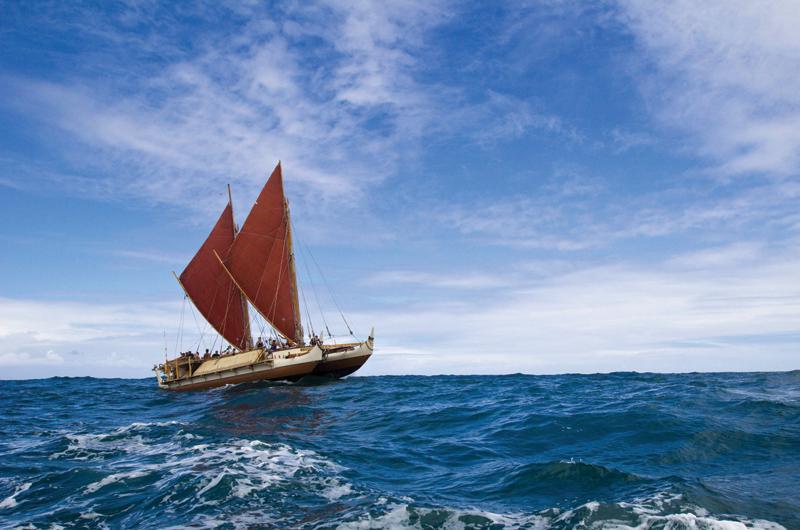
Low’s infatuation with this particular vessel grew from a pair of powerful childhood influences: his own family heritage and his love of the ocean. His father, Sanford Low, was Hawaiian and his mother, Virginia Hart, was a descendant of William H. Hart, who in 1911 bought the farm in Oak Bluffs that became Harthaven. As a child growing up in Oak Bluffs, Low spent summers venturing out from his family’s home, exploring the Island’s many ponds and beaches.
“The ocean was our playground,” he said. “We spent every summer here. I was in the water all of the time.”
As a teenager, Low and his friends began scuba diving, towing a homemade underwater sled and loading it up with buried treasure. “We got involved in trying to find shipwrecks,” he remembered, looking out through the living room’s wall of windows, over Farm Pond. “We dove in the Port Hunter, probably five to six times a week.”
What treasure the boys discovered, from Vineyard Haven harbor to the Elizabeth Islands, they carried ashore and studied, sharing some with the Dukes County Historical Society (now the Martha’s Vineyard Museum). “We brought up portholes, plates – we ate off the plates for a while – egg cups, all kinds of things.”
Bringing up pieces of Island history from the depths of the ocean inspired in Low a love of underwater archaeology, which he went on to study more formally, earning degrees at both Yale and Harvard. For a time, he traveled to the Mediterranean on National Geographic Society excavations, where he helped to dig up ancient seaports and shipwrecks.
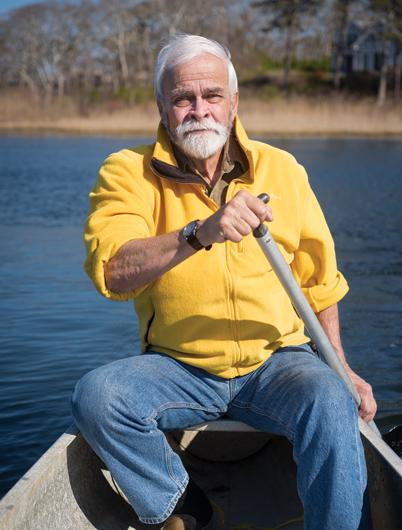
A running counterpoint to his passion for the ocean and budding interest in the study of ancient cultures and civilizations was his father’s family background. Though it wasn’t until his college years that Low turned his academic interests toward ancient Polynesian explorers, his love of all things Hawaiian began much earlier. “It started when I was born,” he said. “My father loved to sing the songs, my mother learned to dance hula. There was this aroma of Hawaii just wafting through the house, and I was always curious about it.”
Low’s father, who was called Sandy, first came to the continental United States at the age of seventeen as a boarding school student, but ran off shortly after to work as a quartermaster on ships going up and down the East Coast. A gifted artist, he went on to study at the Museum School in Boston, and eventually became the director of the New Britain Museum of American Art in New Britain, Connecticut. But it was the time he spent on the Vineyard with his wife’s family that Sandy cherished most. “He told me that if he didn’t have Martha’s Vineyard, he wouldn’t have been able to stay on the East Coast,” Low said. “It reminded him so much of his own islands in Hawaii. Here’s a place to fish, to have a boat, here are people that love to be on the water and love to swim, and here’s a family. There was this sense of ‘ohana – extended family – that he found in the Hart family here.”
Though the elder Low dreamed of returning one day to his family compound on the Big Island of Hawaii, the trip was long and expensive and there was always a reason to stay. It wasn’t until 1964, when Sam Low enlisted in the Navy, strategically requesting a ship assignment out of Pearl Harbor, that his father began talking more seriously of going back.
“The day I left he embraced me and gave me his blessing, and said that he would see me in Hawaii later that year,” Low said. “He had decided to go home – ‘go home’ he still called it – because I would be there and this was the time.”
Sadly, the reunion wasn’t to be. Sandy Low died that same night.
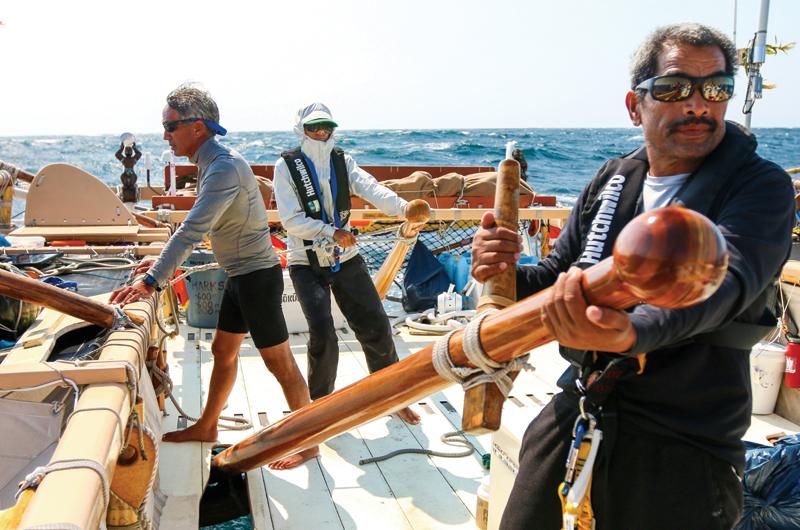
Years later, when Low was training for his first voyage on an escort vessel that would trail in the Hokule‘a’s wake, he was swimming off Cape Pogue on Chappaquiddick, where his family had spread his father’s ashes some thirty years before. “I took a little bottle and I collected water from off the Pogue and put it in my pocket,” he said. “I had no idea what I was going to do with it, but I was bringing the Vineyard and my father with me.”
As a college student in the 1960s, Low embarked on a study of his Hawaiian ancestors. The question of how Polynesia had originally been settled, and by whom, remained unanswered, and Low began to research various theories. “It was a quandary in those days,” he said. Reigning wisdom still favored Norwegian explorer Thor Heyerdahl, who, in 1947, sailed his Kon-Tiki expedition, following winds and currents from Peru into the Pacific on a hand-built raft.
“We thought that Polynesia had been settled by people drifting on rafts, because they didn’t have metallurgy and they didn’t have writing and they didn’t have charts or compasses,” Low explained. “So how could they have been really good mariners? It must have just been accidental.”
But years of close study were beginning to prove otherwise: archaeological, botanical, and ethnographic findings showed that the earliest visitors had come from another direction. “It turned out they came the other way,” Low said. “They came from South East Asia, against the winds and currents.”
At the same time, Low was happening upon evidence of “these wonderful, beautiful, very seagoing double-hulled canoes” that ancient Polynesians had built and used to explore the surrounding islands. This discovery led Low, along with many other scholars (“I was just a lowly student reading about it”) to believe that his ancestors were far more sophisticated than they had once been presumed.
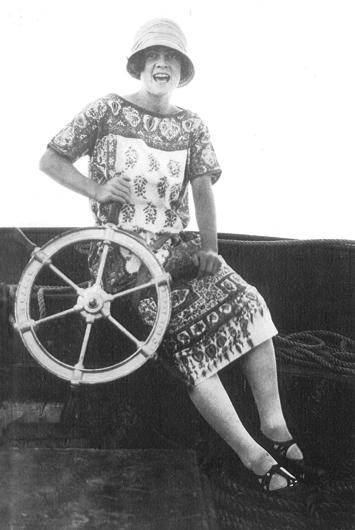
Meanwhile, on the Big Island of Hawaii, an artist named Herb Kane was overseeing a project to build a replica of an ancient voyaging canoe. Spurred by a climate of Hawaiian cultural revival, Kane and others believed they could prove to the world, once and for all, that using nothing but traditional navigation techniques, their Polynesian ancestors had been among the world’s greatest explorers, settling one-third of the earth centuries before their European counterparts.
In 1976, Hokule‘a sailed her first voyage to Tahiti, where she was greeted by more than 17,000 people. Led by traditional navigator Mau Piailug of Micronesia, the journey was 2,400 miles and marked the beginning of what has now been four decades of voyaging around the Polynesian islands and beyond, using ancient navigation techniques.
Piailug returned to Hawaii to train a new generation of navigators, a group that included, by coincidence, one of Low’s cousins, Nainoa Thompson. By this point, Low had been reading of Hokule‘a’s voyages in National Geographic and felt a calling to be more involved. “After I first heard about the canoe I kept going back to Hawaii every other year as much as I could,” Low said. “I met Nainoa when I was in the Navy, and he was a little kid. Eighteen years later he had learned to navigate from this master navigator.”
In 1980, Thompson became the first Hawaiian to repeat Piailug’s success at navigating Hokule‘a with no instruments or modern navigational tools to Tahiti and back. Inspired by his cousin’s achievements and the cultural renaissance in Hawaii, Low – by then well into his career as a documentary filmmaker – decided to make a film. The Navigators: Pathfinders of the Pacific, a one-hour movie made for PBS, continues to be shown on television and in classrooms today.
Mariners and explorers often write of “raising” land; the experience of seeing an island or stretch of coast appear, looming on the horizon, from the confines of an approaching vessel.
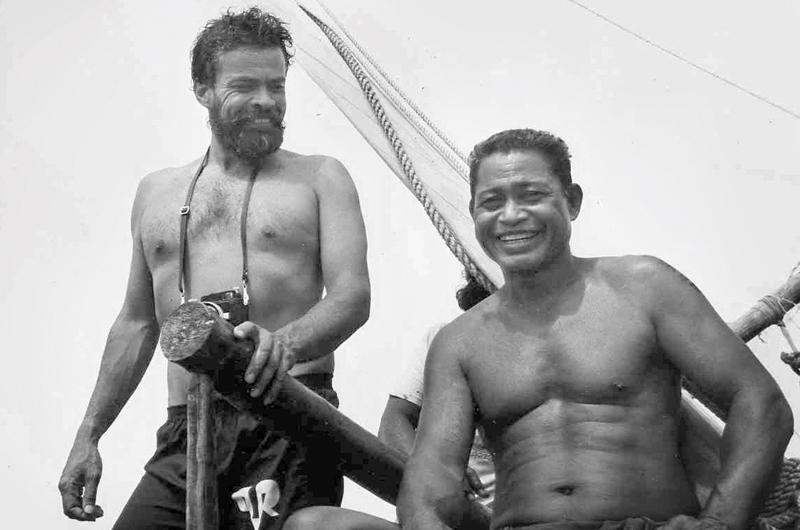
It’s a feeling Low hasn’t forgotten. “It’s very emotional to pull an island out of the ocean,” he mused. “There’s this serious magic; it’s like a thing that grows out of the ocean and gets closer and closer.”
In 1995, after life and his career had taken him in other directions, Low was visiting family in Hawaii when he received his first invitation to travel with the crew of the Hokule‘a. He had come to see the canoe off on yet another voyage when his cousin spotted him in the crowd. “Nainoa came over to me and said he’d get a berth for me on the escort boat,” Low remembered. Days later, Low secured a spot on the return voyage; he would sail in Hokule‘a’s wake, ensuring her safe passage.
It was an invitation Low had been waiting for decades to accept, though he wondered if he would be physically prepared for the trip. “I felt like I was getting a little old for this,” he admitted. “But Nainoa could see that I was curious. He could see I had a spiritual connection to voyaging and to that part of my ancestry. It was something I could understand intimately right away.”
In 1999, four years after sailing on the escort ship, Low was invited to join the crew of Hokule‘a on a voyage from Mangareva in the Gambier Islands of French Polynesia to Rapa Nui (Easter Island.) “It’s considered to be one of the more difficult voyages because the winds are coming usually very strong against you,” Low said. It was expected to take as long as two months, but under Thompson’s expert guidance, they completed the trip in seventeen days.
On that first voyage as a crewmember on the canoe itself, he composed a short narrative every day, which he delivered over satellite phone to be posted online. “All of the other stuff – my involvement with the ocean, with history – prepared me for the journey,” he said. “I’m a writer and a photographer – my job was to document the voyage. Here I was, on this ancestral vessel with a kuleana – a task, a mission. And it was to do what I loved doing, writing and taking pictures.”
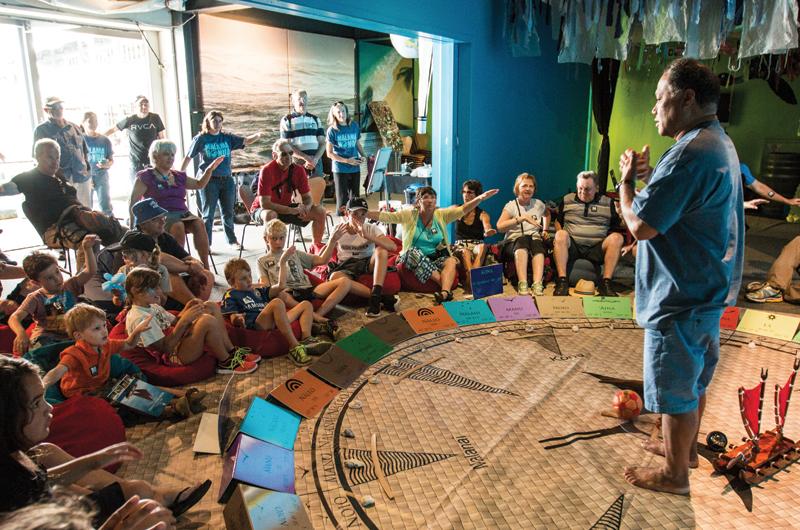
His collections of writings eventually grew into a book, Hawaiki Rising, which was published in 2013 and promptly won the Hawai’i Book Publisher’s Association Book of the Year. By then, plans were underway for Hokule‘a’s grand expedition around the world. Low timed the release of his book with her initial departure from Hawaii.
The book is a thorough exploration of the history of Hokule‘a, with a focus on Thompson and his journey to becoming a master navigator in the tradition of his ancestors. But it’s Low’s own experiences on the boat that remain with him most vividly, the opportunity he had to be a part of a powerful journey that he says challenged him physically, mentally, and spiritually.
“The idea that you have – with your brothers and sisters on the vessel – you’ve formed a family, you’ve looked out for each other for seventeen days…” Low said, trailing off. “It’s the kind of experience that you don’t get very often on land.”
Low and his fellow crewmembers stood four-hour watches, manning the massive steering paddle and serving as lookouts. At night, they steered by the stars, under the watchful eye of the navigator who corrected them if they strayed off course.
“You’re watching your star; you’re feeling the motion of the canoe in your feet,” Low recalled, positioned in front of the fireplace in his living room, bending and straightening his knees as if transported to the open sea. “It’s unlike steering any other vessel. You are joined with the canoe with your muscles, your eyes. You hear the rushing of the wind, you hear the sibilance of it, and you want to keep that song in the right octave. It’s this incredible ballet, connected to every part of your being and your senses.”
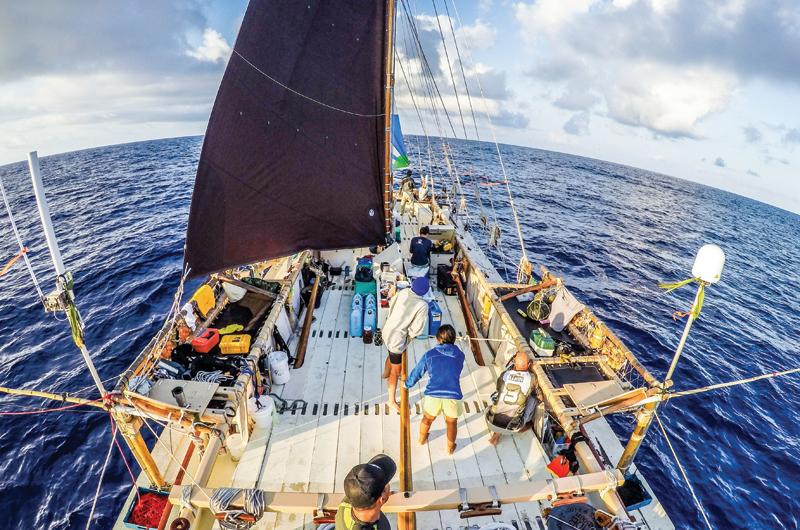
But more than the physical work or the canoe itself, it was the skill of the navigators that Low found most impressive. Voyage after voyage, Thompson and a handful of other experienced mariners have been able to guide their crews with confidence, relying only on the stars, wind, wave patterns, and their natural senses to maneuver from one island to another, crossing thousands of miles of open ocean between them.
Hokule‘a’s navigators do not use any charts or instruments that would not have been available to their ancestors; this includes a pencil and paper. “There’s a world of natural signs out there. If you can read them, they can tell you where you’re going and how fast you’re going,” Low explained. “Then it becomes a trick to keep in mind every day, for twenty-four days, where you went, how long you went in that direction, and where land is. The navigator does it all in his mind, because his ancestors did not have writing.”
But they did have stars. And they had what Thompson often refers to as his own “trained instinct.”
“At night, Nainoa can see the stars rising and setting, so he can steer his canoe better than he can with a magnetic compass,” Low said. “He also has a holistic view of the sky. He’s navigating by trained instinct. It’s not magic, but it’s from the heart.”
Though he’s spent much of his life on the water in one way or another, from sailing his 28’ sailboat in Maine to serving as the officer in charge (“officer of the deck”) for four-hour watches on a 655’ oiler in the Navy, Low’s time on the Hokule‘a remains an unparalleled experience.
“Finding land after a long ocean voyage and being at sea for days with nothing in sight, no ships, just the stars and your canoe,” Low reminisced. “Holy shit, it’s amazing.”
In the years that followed, Low would make two more trips on the canoe. In 2000 he joined the crew for a voyage from Tahiti to Hawaii, and in 2007 he sailed again, from Chuuk,
in Micronesia, to Satawal, one of the Caroline Islands in the North Pacific. On all three of his voyages, he carried the small vial of water he had collected from off Cape Pogue in his
shirt pocket.
“Whenever I felt my father’s spirit I would go up to the bow and I would put a little water in the ocean,” Low said. “That was my first real introduction to what it was like to be on this spaceship of our ancestors, this replica of a very ancient vessel that must have sailed those waters many times.
“You feel your past come back to you, you feel your own ethnicity. It was a very spiritual journey.”
To follow the progress of Hokule‘a’s global voyage and find out more about events surrounding her visit to the Vineyard, go to hokulea.com.

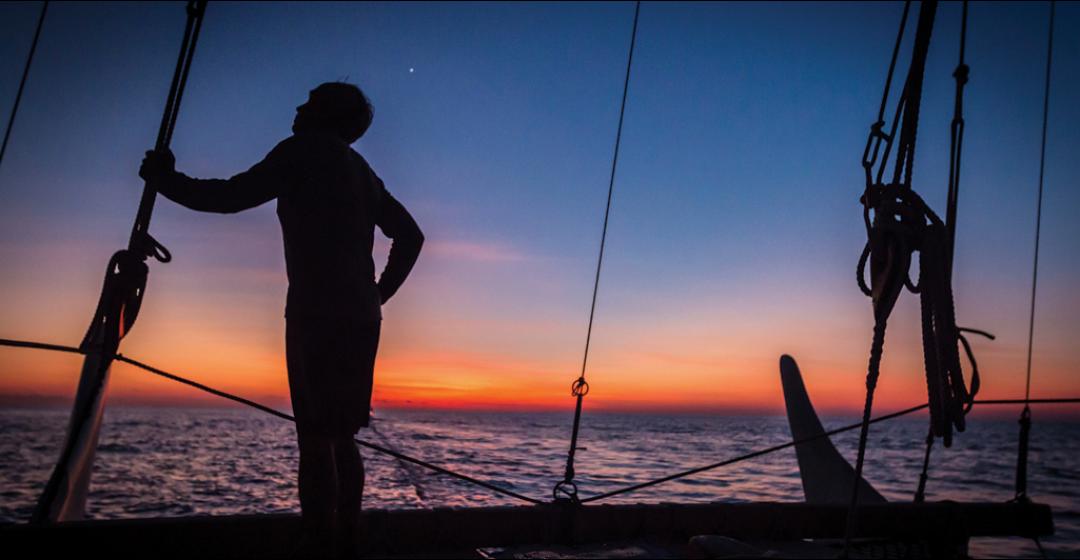


 5 comments
5 comments
Comments (5)